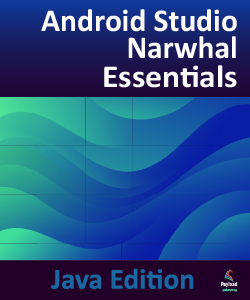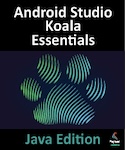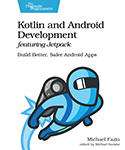About This Title
Pages: 698
Published: August 2025
ISBN: 9781965764220
In Print
Android Studio Narwhal Essentials-Java Edition
by Neil Smyth
Android Studio Narwhal Essentials-Java Edition is a comprehensive guide to developing Android apps using Android Studio and Java. This book is suitable for novice and experienced programmers and serves both as a learning tool and a reference guide you can return to as you progress through the Android app development learning process and start developing your own apps.
The book starts with the basics, explaining how to install and use Android Studio and AVD emulators before delving into the world of Android app development, from foundational techniques to advanced development topics.
This work was written and produced entirely by the author. We are proud to be distributing it.
eBook Formats:
PDF for desktop/tablets
epub for Apple Books, e-readers
Get all eBook formats here for $38.99 (USD)
This book, fully updated for Android Studio Narwhal Feature Drop, teaches you how to develop Android-based applications using Java. Beginning with the basics, the book outlines how to set up an Android development and testing environment, followed by an overview of areas such as tool windows, the code editor, and the Layout Editor tool. An introduction to the architecture of Android is followed by an in-depth look at the design of Android applications and user interfaces using the Android Studio environment.
Chapters also cover the Android Architecture Components, including view models, lifecycle management, Room database access, content providers, the Database Inspector, app navigation, live data, and data binding.
Topics such as intents, touchscreen handling, gesture recognition, and the integration of artificial intelligence into Android apps are also included.
The concepts of material design are also covered in detail, including the use of floating action buttons, Snackbars, tabbed interfaces, card views, and collapsing toolbars.
Other key features of Android Studio and Android are also covered in detail, including the Layout Editor, the ConstraintLayout and ConstraintSet classes, view binding, constraint chains, barriers, and direct reply notifications.
Chapters also cover advanced features of Android Studio, such as Gradle build configuration, in-app billing, and submitting apps to the Google Play Developer Console.
Assuming you already have some Java programming experience, are ready to download Android Studio and the Android SDK, and have access to a Windows, Mac, or Linux system, you are ready to get started.
What You Need
- Windows 10 or 11 64-bit
- macOS 12 or later running on Intel or Apple silicon
- Chrome OS device with Intel i5 or higher
- Linux systems with version 2.31 or later of the GNU C Library (glibc)
- Minimum of 16 GB of RAM
- Approximately 8 GB of available disk space
- 1280 x 800 minimum screen resolution
Resources
Releases:
Contents & Extracts
1. Introduction2. Setting up an Android Studio Development Environment
3. Creating an Example Android App in Android Studio
4. Creating an Android Virtual Device (AVD) in Android Studio
5. Using and Configuring the Android Studio AVD Emulator
6. A Tour of the Android Studio User Interface
7. Testing Android Studio Apps on a Physical Android Device
8. The Basics of the Android Studio Code Editor
9. An Overview of the Android Architecture
10. The Anatomy of an Android App
11. An Overview of Android View Binding
12. Introducing Gemini in Android Studio
13. Understanding Android Application and Activity Lifecycles
14. Handling Android Activity State Changes
15. Android Activity State Changes by Example
16. Saving and Restoring the State of an Android Activity
17. Understanding Android Views, View Groups and Layouts
18. A Guide to the Android Studio Layout Editor Tool
19. A Guide to the Android ConstraintLayout
20. A Guide to Using ConstraintLayout in Android Studio
21. Working with ConstraintLayout Chains and Ratios in Android Studio
22. An Android Studio Layout Editor ConstraintLayout Tutorial
23. Manual XML Layout Design in Android Studio
24. Managing Constraints using Constraint Sets
25. An Android ConstraintSet Tutorial
26. A Guide to Using Apply Changes in Android Studio
27. A Guide to Gradle Version Catalogs
28. An Overview and Example of Android Event Handling
29. Android Touch and Multi-touch Event Handling
30. Detecting Common Gestures Using the Android Gesture Detector Class
31. Implementing Custom Gesture and Pinch Recognition on Android
32. An Introduction to Android Fragments
33. Using Fragments in Android Studio - An Example
34. Modern Android App Architecture with Jetpack
35. An Android ViewModel Tutorial
36. An Android Jetpack LiveData Tutorial
37. An Overview of Android Jetpack Data Binding
38. An Android Jetpack Data Binding Tutorial
39. An Android ViewModel Saved State Tutorial
40. Working with Android Lifecycle-Aware Components
41. An Android Jetpack Lifecycle Awareness Tutorial
42. An Overview of the Navigation Architecture Component
43. An Android Jetpack Navigation Component Tutorial
44. Working with the Floating Action Button and Snackbar
45. Creating a Tabbed Interface using the TabLayout Component
46. Working with the RecyclerView and CardView Widgets
47. An Android RecyclerView and CardView Tutorial
48. Working with the AppBar and Collapsing Toolbar Layouts
49. An Overview of Android Services
50. An Overview of Android Intents
51. Android Explicit Intents - A Worked Example
52. Android Implicit Intents - A Worked Example
53. Android Broadcast Intents and Broadcast Receivers
54. Android Local Bound Services - A Worked Example
55. Android Remote Bound Services - A Worked Example
56. An Overview of Java Threads, Handlers and Executors
57. Making Runtime Permission Requests in Android
58. An Android Notifications Tutorial
59. An Android Direct Reply Notification Tutorial
60. An Overview of Android SQLite Databases
61. An Android SQLite Database Tutorial
62. Understanding Android Content Providers
63. An Android Content Provider Tutorial
64. An Android Content Provider Client Tutorial
65. The Android Room Persistence Library
66. An Android TableLayout and TableRow Tutorial
67. An Android Room Database and Repository Tutorial
68. Creating, Testing, and Uploading an Android App Bundle
69. An Overview of Android In-App Billing
70. An Android In-App Purchasing Tutorial
71. An Android Biometric Authentication Tutorial
72. Integrating Gemini AI into Android Apps
73. Preparing the Gemini Firebase AI Logic Project
74. A Gemini AI Tutorial
75. Using Gemini AI for Video Analysis
76. Gemini AI Image Generation
77. Working with Material Design 3 Theming
78. A Material Design 3 Theming and Dynamic Color Tutorial
79. An Overview of Gradle in Android Studio
Index
Author
Neil Smyth has more than 25 years of experience in the IT industry, including software development, project management, and marketing. He has a Bachelor of Science degree in Information Technology and holds several certifications, including A+, Security+, Network+, Project+, Java Associate, and Microsoft Certified Professional. Neil is also a CIW Database Design Specialist.
Neil is the co-founder and CEO of Payload Media, Inc., a technical content publishing company. He is also an author who has written several programming and system administration books under the “Essentials” range. Notable titles include Android Studio Development Essentials, Jetpack Compose Essentials, iOS App Development Essentials, C# Programming Essentials, and Ubuntu Essentials.
eBook Formats:
PDF for desktop/tablets
epub for Apple Books, e-readers
Get all eBook formats here for $38.99 (USD)
Related Titles:
About This Title
Pages: 698
Published: August 2025
ISBN: 9781965764220
Edition: 1
In Print




